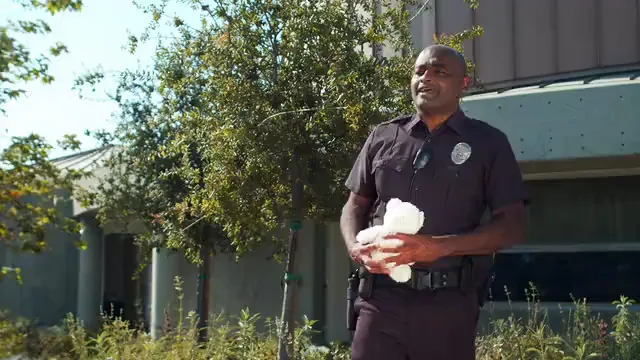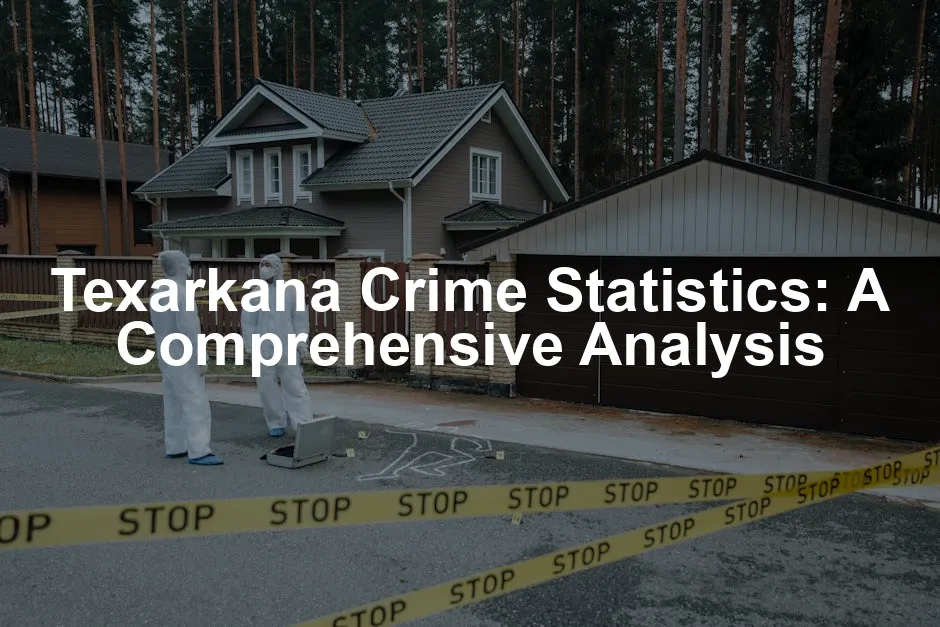Introduction
Texarkana, Texas, is a unique city straddling the Texas-Arkansas border. Known for its vibrant community and rich history, it plays an essential role in regional commerce and culture. With a population of around 37,000, Texarkana offers a blend of small-town charm and urban amenities. However, like many cities, it faces its share of challenges, particularly related to crime.
Understanding crime statistics is crucial for residents, potential movers, and local authorities. These numbers provide a lens through which to view the safety and security of the community. They help residents make informed decisions about their living conditions and can influence potential movers considering Texarkana as their future home. Local authorities can use this data to allocate resources effectively, develop crime prevention strategies, and engage with the community.
The aim of this article is to provide a detailed analysis of crime statistics in Texarkana. We will compare the city’s crime rates with national averages and nearby cities. By examining these figures, we can gain a clearer picture of Texarkana’s safety landscape, helping everyone from prospective residents to community leaders understand where improvements may be needed.

Crime Rate Overview
General Crime Statistics
Texarkana currently has a total crime rate of 33 incidents per 1,000 residents, which is notably higher than the national average. This figure indicates that individuals living in Texarkana face a 1 in 30 chance of becoming a victim of any crime. Comparatively, over 92% of communities in Texas report lower crime rates, raising concerns about safety in the area.
When we look at violent crimes specifically, Texarkana’s rate stands at 4 per 1,000 residents. This means residents have a 1 in 239 chance of being affected by violent crime, a statistic that may cause unease among locals. Property crime is where Texarkana really stands out—boasting a rate of 29 per 1,000 residents. This translates to a 1 in 34 chance of becoming a victim of property crime, including theft and burglary.
To enhance personal safety, consider investing in a Personal Safety Alarm Keychain. This handy device can provide an extra layer of security and peace of mind, especially when you’re out and about alone. With just the press of a button, it can emit a loud sound to deter potential threats, making it a must-have for anyone concerned about safety.
Surveys conducted by AreaVibes indicate a mixed perception of public safety among residents. While some feel secure in their neighborhoods, many express concerns about walking alone at night. In fact, only 28% of residents believe that crime rates are low, highlighting a significant gap between statistical data and community sentiment.
Understanding these statistics is vital not just for current residents but also for those considering relocating. High crime rates can impact property values, insurance rates, and quality of life. Therefore, it is essential to analyze these figures thoroughly to grasp the safety landscape of Texarkana effectively. For a more in-depth look at Texas crime rate statistics, understanding the broader context can help.
Analyzing crime statistics is crucial for understanding safety in Texarkana. Learn more about Texas crime rate statistics.

Violent Crime Statistics
Texarkana’s violent crime rate stands at 4 per 1,000 residents, translating to a 1 in 239 chance of becoming a victim. This rate is notably higher than the national average of approximately 3.9 per 1,000. Let’s break it down further:
- Murder: There were 2 reported cases (0.06 per 1,000 residents).
- Rape: A total of 13 incidents (0.36 per 1,000).
- Robbery: 28 incidents reported (0.78 per 1,000).
- Assault: This category topped the list with 107 incidents (2.99 per 1,000).
Compared to the national averages, Texarkana’s murder and robbery rates are lower, while its assault figures are slightly elevated. The odds of encountering violent crime make it crucial for residents to stay vigilant, particularly during late-night outings. Consider keeping a Self-Defense Pepper Spray handy to help protect yourself in unexpected situations. It’s compact, easy to carry, and can provide the confidence you need to navigate your surroundings more safely.

Property Crime Statistics
When it comes to property crime, Texarkana exhibits a rate of 29 per 1,000 residents, significantly surpassing the national average of 22. Property crimes account for a 1 in 34 chance of victimization. Here’s the detailed breakdown:
- Burglary: 105 incidents (2.93 per 1,000).
- Theft: A staggering 821 incidents (22.95 per 1,000).
- Motor Vehicle Theft: 119 incidents (3.33 per 1,000).
These statistics paint a worrisome picture. While the burglary rate is relatively low compared to national figures, theft stands out alarmingly high, indicating that residents might want to be extra cautious about securing their belongings. To enhance your home security, consider investing in a Home Security System with Camera. This system can help monitor your property and deter potential intruders, giving you peace of mind while you’re away.
Overall, property crime in Texarkana presents a material concern for community safety. For further insights into crime statistics, it’s important to consider broader trends.
Understanding property crime rates is essential for community safety in Texarkana. Explore Fremont crime statistics for a broader perspective.

Historical Crime Trends
Year-over-Year Crime Trends
Analyzing crime trends in Texarkana over the past decade reveals a rollercoaster ride of statistics. In 2018, violent crime soared, reaching alarming heights of over 1,200 incidents per 100,000 residents. However, the last few years have shown promising declines, with violent crime decreasing by approximately 46% by 2022. This drop reflects a concerted effort by local law enforcement to implement community-based safety measures.
In contrast, property crime followed a different trajectory. In 2016, property crime rates reached a peak of 8,371 incidents per 100,000 residents. Since then, however, this figure has steadily declined, dropping by about 12% in recent years. The most recent data indicates a property crime rate of 2,914 per 100,000, still higher than the national average but showing improvement.
Significant fluctuations in crime rates often correlate with socioeconomic factors. As Texarkana continues to address challenges like poverty and education, the hope is that crime rates will further diminish. The community’s resilience and proactive measures may indeed create a safer environment for residents.
To further prepare for emergencies, consider assembling an Emergency Survival Kit that includes essential items like food, water, and first aid supplies. Being prepared can make all the difference when facing unexpected situations.
In conclusion, while Texarkana faces notable crime challenges, the current trends suggest a positive trajectory towards enhanced safety. Continued vigilance and community engagement remain vital in this endeavor.

Comparison with Nearby Cities
When looking at crime statistics, context is king. So, how does Texarkana stack up against its neighbors like Wake Village, Nash, and Hooks? Spoiler alert: It’s a mixed bag.
Starting with Wake Village, this charming spot boasts a violent crime rate of just 34 per 100,000 residents. That’s a significant drop compared to Texarkana’s 4 per 1,000 residents. The reasons are clear: Wake Village features a close-knit community vibe, low population density, and a greater emphasis on community policing.
Moving over to Nash, the numbers tell a similar story. With a violent crime rate of 238 per 100,000 residents, it still lags behind Texarkana but remains lower than many urban areas. Nash’s community programs and proactive local governance likely play a role in keeping crime at bay.
Hooks, on the other hand, shines the brightest in our comparison. A mere 72.9 violent crimes per 100,000 residents make Hooks a safe haven. Low socioeconomic challenges and active community engagement contribute to this favorable statistic.
Why the differences? Socioeconomic factors, community engagement, and local governance all play a part. While Texarkana grapples with higher crime rates, its neighbors showcase how effective community strategies can pave the way for safer environments.

If you’re looking to enhance your home’s security, consider installing a Smart Door Lock with Keypad. This modern solution not only enhances security but also provides convenience, allowing you to control access to your home without the hassle of traditional keys.
Neighborhood-Specific Crime Analysis
Safest Neighborhoods in Texarkana
In a city where crime rates can be alarming, certain neighborhoods stand out as safe havens. Red Lick tops the list, known for its friendly community and active neighborhood watch. Next up, Texarkana Northwest offers a mix of residential charm and vigilant residents, ensuring lower crime incidents.
Eylau and Spring Lake Park also deserve a shout-out. These neighborhoods benefit from community programs that involve residents in safety initiatives. Low crime rates here aren’t just luck; they’re a result of engaged citizens working together.
Characteristics contributing to their safety include stable homeownership rates, local schools encouraging community involvement, and active neighborhood associations that foster communication among residents. Safety isn’t merely a statistic; it’s a way of life in these areas.

High Crime Areas
Conversely, Texarkana has neighborhoods where crime rates send shivers down spines. Downtown Texarkana often faces higher property crime rates, particularly theft. Why? The bustling activity and transient population create opportunities for petty criminals.
Another hotspot is South Texarkana, where socioeconomic challenges are evident. With a poverty rate exceeding the national average, residents often face increased crime risks. Factors like unemployment and lack of access to quality education contribute to the crime prevalence in this area.
Texarkana Northeast also struggles with a higher incidence of violent crime. Local governance is working hard to combat these issues, but challenges remain. A lack of community cohesion and resources can hinder safety efforts, making it a focus for future improvement.
Addressing the elevated crime in these areas involves tackling root causes. Community programs emphasizing education, employment opportunities, and access to social services can pave the way for transformation. In this dynamic environment, the community must unite to create a safer Texarkana for everyone.

Community Sentiment and Law Enforcement
Public Perception of Crime
Community sentiment in Texarkana regarding safety and crime is a mixed bag. A recent survey by AreaVibes reveals that only 28% of residents feel secure and believe crime rates are low. That leaves a whopping 72% feeling uneasy about walking alone at night. It seems like the only thing more common than a Texarkana sunrise is a resident’s concern about safety.
Interestingly, these sentiments align closely with reported crime statistics. Texarkana’s overall crime rate stands at 33 per 1,000 residents, considerably higher than the national average. This figure translates to a 1 in 30 chance of becoming a victim of any crime, which creates a palpable sense of anxiety among locals. Despite the statistical evidence suggesting a decrease in crime rates in recent years—violent crime reportedly decreased by 46% since 2018—public perception hasn’t quite caught up.
The contrast between the data and community sentiment highlights a crucial issue. While the numbers may reflect a safer environment, the lingering fears among residents indicate a disconnect. Trust in law enforcement and community safety initiatives is vital for changing this narrative. It appears that while statistics may provide a numerical sense of security, nothing beats the feeling of safety that comes from personal experience.

Law Enforcement Overview
Texarkana’s local law enforcement comprises about 104 employees, translating to approximately 2.8 officers per 1,000 residents. This is slightly below both the Texas state and national averages. The police department’s structure allows officers to engage in community policing, which aims to build trust within neighborhoods. However, community feedback suggests varying levels of effectiveness.
According to a community poll, 50% of respondents view law enforcement as “very visible and responsive.” However, 29% feel they are visible but slow to respond. This mixed feedback indicates that while many appreciate the police presence, there’s still room for improvement, particularly in response times. For many residents, a delayed response can turn a minor concern into a major issue.
Crime response times are pivotal in shaping community sentiment. For instance, when officers respond quickly to calls, it fosters trust and reassurance. But, if response times lag, it can exacerbate feelings of insecurity. The community’s perception of safety hinges not only on crime statistics but also on how effectively law enforcement can address issues as they arise.
In summary, while Texarkana’s law enforcement has made strides in creating a safer environment, building stronger relationships with the community remains a key area for growth. Understanding this dynamic can help both residents and law enforcement work towards a common goal: a safer Texarkana for everyone.

Methodology of Data Collection
Crime data in Texarkana is collected through a combination of local law enforcement reports and national databases, including the FBI’s Uniform Crime Reporting (UCR) Program. Every year, over 18,000 local law enforcement agencies contribute to this extensive compilation. Each agency submits data on various crime incidents, allowing for a comprehensive view of crime trends.
The importance of data accuracy cannot be overstated. Accurate crime statistics guide public policy decisions, resource allocation, and community safety initiatives. For example, if property crimes are on the rise, local authorities can focus efforts on crime prevention strategies tailored to those specific issues. Conversely, misleading or inaccurate data could lead to misguided policies that fail to address the root causes of crime.
Moreover, the ongoing update of these statistics—typically reflecting the previous calendar year—ensures that decision-makers have current information at their fingertips. This timely data is crucial for evaluating the effectiveness of crime reduction initiatives and adjusting strategies as needed.
The implications of crime statistics extend far beyond mere numbers. They inform everything from community safety programs to law enforcement training and public awareness campaigns. In Texarkana, as elsewhere, understanding crime data is essential for fostering a safe and engaged community.

In conclusion, the methodology behind crime data collection is crucial for shaping public safety policies. Accurate, timely data helps create a responsive and responsible approach to crime reduction, ultimately contributing to a safer Texarkana for all.
Conclusion
In wrapping up our exploration of crime statistics in Texarkana, it’s clear that the city faces notable challenges. With a total crime rate of 33 incidents per 1,000 residents, Texarkana surpasses the national average. Residents have a 1 in 30 chance of becoming a victim of crime—a sobering statistic that can make anyone think twice about their surroundings.
When we zoom in on specific areas, the violent crime rate stands at 4 per 1,000 residents. The odds of being affected by violent crime are considerably better than some larger cities, but still, the numbers speak for themselves. Property crime, however, is where things get a bit worrisome. At 29 per 1,000 residents, the chances of experiencing property crime are significantly higher, with theft being particularly prevalent.

To ensure your safety while traveling or living in Texarkana, consider keeping a LED Flashlight with Zoom handy. This compact tool can illuminate your path during late-night excursions and can be invaluable in emergency situations, providing a sense of security when you need it most.
The importance of ongoing monitoring cannot be overstated. Crime statistics are not just numbers; they represent real people and communities. Local authorities must keep a pulse on these trends to develop effective strategies for crime reduction. This is where community engagement steps in. By working together, residents and law enforcement can create a safer environment, fostering trust and collaboration.
For those considering a move to Texarkana or planning a visit, it’s essential to weigh these statistics. Awareness of crime rates can help individuals make informed decisions about where to live or travel. After all, knowledge is power, and understanding the safety landscape of Texarkana can lead to a more secure experience for everyone involved. Let’s stay engaged, remain vigilant, and strive for a safer Texarkana together.

FAQs
What are the chances of becoming a victim of crime in Texarkana?
In Texarkana, the overall chance of becoming a victim of crime is about 1 in 30. For violent crime, the odds improve slightly to 1 in 239. However, property crime remains a concern, with a 1 in 34 chance of experiencing theft or burglary. Comparatively, this rate is higher than many cities in Texas, where over 92% report lower crime rates.
How does Texarkana’s crime rate compare to other cities in Texas?
When stacked against other Texas cities, Texarkana doesn’t fare particularly well. For instance, Wake Village boasts a crime rate significantly lower than Texarkana’s, with only 34 violent crimes per 100,000 residents. Nash and Hooks also report lower rates, making them safer choices for prospective residents. In contrast, Texarkana’s crime rate of 1,195 incidents per 100,000 puts it above many of its neighbors.
What initiatives are in place to reduce crime in Texarkana?
Local authorities have recognized the need for crime reduction initiatives in Texarkana. Community policing strategies have been implemented, focusing on building relationships between law enforcement and residents. Programs aimed at youth engagement, neighborhood watch groups, and crime prevention education are also in place to empower citizens and foster a safer community.
Are there resources available for crime victims in Texarkana?
Yes, Texarkana offers various resources for crime victims. Local organizations provide support services, including counseling, legal assistance, and shelters for those in need. Additionally, there are hotlines and community centers that can guide victims through the recovery process, ensuring they receive the help required to heal.
How can residents contribute to community safety?
Residents can play a vital role in enhancing community safety by staying informed and engaged. Joining neighborhood watch programs, attending community meetings, and communicating with law enforcement can make a difference. Simple actions like reporting suspicious activities and participating in local safety initiatives can lead to a safer Texarkana for everyone. Together, vigilance and community involvement can create an environment where crime is less likely to thrive.
Please let us know what you think about our content by leaving a comment down below!
Thank you for reading till here 🙂
All images from Pexels




